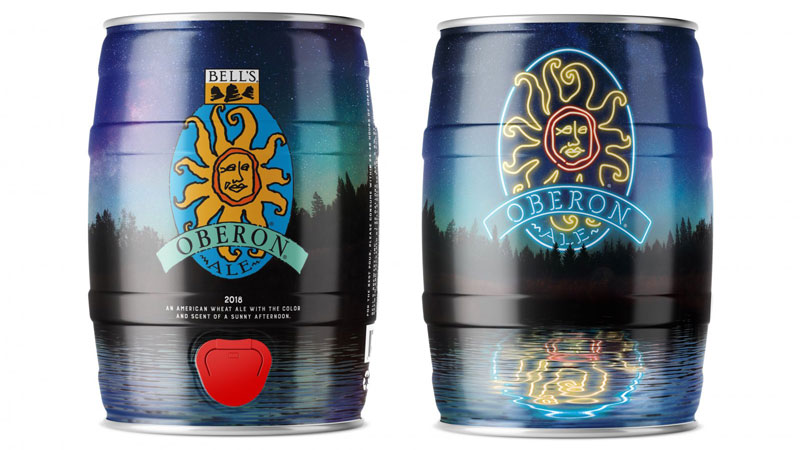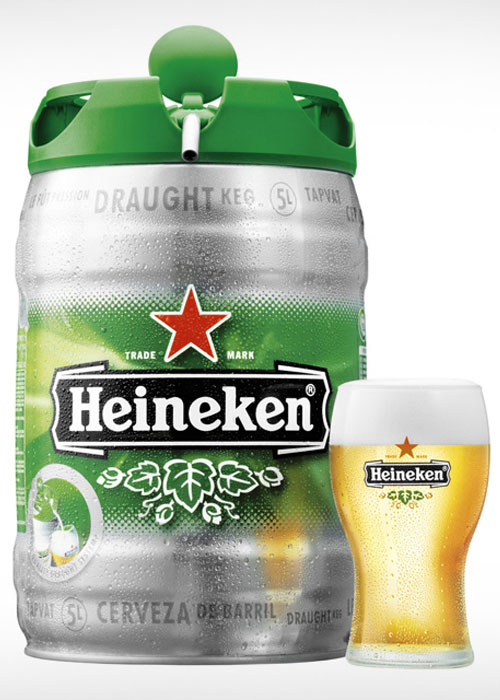As a huge fan of Rothaus — the Black Forest brewery with the German woman in a dirndl on its label — I’d always scoured the web to learn all I could about this somewhat mysterious brand. Government-owned, Rothaus is not exactly revered over there, or so I’ve been told by German friends. But in the few, select American cities that receive bottles — namely, Brooklyn — its Tannenzäpfle pilsner has become a cult sensation over the last half-decade.
And yet, my Rothaus-loving ilk and I wanted more. Why didn’t Rothaus send its other styles to the U.S.? Was there really a Rothaus hotel (complete with branded pillows!) in Grafenhausen? I recall one day, Joshua van Horn, co-owner of Gold Star Beer Counter in Prospect Heights, clued me into the fact that Rothaus produces 5-liter mini kegs of the pilsner. We were both in awe, but, unfortunately, he told me, they would never distribute any to America.
Why would they? Mini kegs have never exactly been a thing in America, certainly not a craft beer thing.
Until now.
DraughtKeg
Just about two decades back, in 1997, a 20-something engineer in Heineken’s research lab, Harold Vlooswijk, was tasked with shrinking the beer keg. Heineken was looking to make a splash with the brand — not so easy for a Dutch beer that had maintained the same recipe and label design since it became a household name in the late 1800s.
The idea was big, but the brand reasoned that there might be a customer base that, while they would never buy 15.5 gallon, bar-size kegs, might still be interested in recreating that draft beer experience from the comfort of their kitchens. Heineken NV had tried to do this before, with its Amstel brand back in the 1990s, though technologically speaking it had really just been producing oversized cans with a spigot; once opened, the beer would go flat almost immediately.
After seven years of Vlooswijk and his team working on the project, scrapping countless flawed designs, in 2005 the Heineken DraughtKeg was finally available in Europe — 5 liters of perfectly dispensed pale lager for a mere $20 or so. The secret was that inside the DraughtKeg, attached to the floor, was a six-inch-tall aerosol canister of CO2. Its top valve would open when pressure above the beer slipped below two atmospheres; enough to propel the beer upward to the top of the mini keg, but not so much that it over-carbonated it (though initial pours were often a tad foamy).
“[I]t’s the biggest thing to come along since somebody put beer in cans,” thought David Williams, then an analyst with a Chicago research firm.
Indeed, the DraughtKeg was an immediate hit, selling 10 million units worldwide by 2007. That same year it launched in the U.S., aiding in Heineken’s double-digit growth. The need to stock these intriguing mini kegs in the middle of supermarket floors and on endcaps, gave them the attention they needed to battle it out with America’s top macro-lagers.
Home Draft
Few American brands were able to capitalize on this technology, however, and Heineken’s entry is still mostly the only mini keg that mainstream, supermarket beer shoppers will have ever encountered. But, as early as 2009, MillerCoors had introduced in six select cities the Home Draft — $20 mini kegs of Miller Lite and Coors Light. The 1.5 gallon (6.8 liter) kegs came in a box with a spigot on their sides à la cask ale, and were intended to stay fresh in any household refrigerator for up to 30 days.
This was right at the start of the subprime mortgage crisis, amidst the rise of craft beer, and macro brands were looking for any way to get attention from customers being more thoughtful with their weekly beer budgets. Even if the mini keg technology, in this case, meant you were now paying 15 percent more for the beer than you would have in just grabbing a case of cans.
“In this economy, we are seeing an increase in packaging innovation in consumer-goods industries,” said Kara Gruver, head of the North America consumer-products practice at consulting firm Bain & Co, at the time. “In many cases, it can be less costly [than creating a new product] and a very effective form of innovation.”
Anheuser-Busch InBev (ABI) would likewise follow suit in 2011 with its Draftmark system. Customers would need to purchase a $49 Draftmark appliance (“which resembles a mod boombox and is about the size of a long 12-pack of soda cans,” according to the St. Louis Post-Dispatch) which they could then stock with $14 1-gallon kegs of Budweiser, Shock Top, Goose Island Honker’s Ale, and other ABI brands. Not surprisingly, it was a total dud, and quietly discontinued (though a few Draftmark systems still remain available on Amazon).
Craft breweries, of course, are more interested in creating new, tasty products than packaging marvels, and that was surely one reason why they remained even less interested in mini kegs — recall this was an era where even canning your beer was still considered a bit déclassé. Perhaps not surprisingly, then, craft beer’s king of canning, Oskar Blues in Lyons, Colo., was one of the first craft breweries to try out mini kegs, releasing 5 liters of its flagship Dale’s Pale Ale to celebrate its fifth anniversary in 2007. Portland, Ore.’s Widmer would likewise offer its popular Hefeweizen in mini kegs. But neither brand would stick with the technology for all that long.
Then there was Bell’s Brewery, one of the earliest pioneers of craft brewing, which launched in Kalamazoo, Mich., in 1985. Founder Larry Bell, a known beer can collector, was well aware of the European tradition of mini kegs, and acquired some empties from a German producer. As early as 2005, his brewery began releasing 5-liter mini kegs of its popular summer seasonal Oberon Ale. They were such a hit that every year since their launch, a new Oberon mini keg, with new artwork, has been released. The brewery also branched out into releasing other beers in mini kegs, including its annual double IPA Hopslam Ale.
“We hit a peak in production numbers about four years ago,” Bell recalls. They almost exclusively sell them in supermarkets these days, and, despite production delays due to — say it with me — supply chain issues, things are looking up. “With Covid and all, with people now socializing at home more, it just makes sense.”

A Mini Showstopper
If, historically, Americans have mostly seen mini kegs as a novelty item at best, or something only Heineken produces at worst, everything seems to have changed this year. Suddenly the craft beer cognoscenti love the mini kegs they have long ignored. Just as it was for me, Rothaus seems to be the impetus, as the brewery has recently made the mini kegs available in 14 American markets, stretching from New York out to Chicago and Nashville, Tenn., and even down to the Carolinas.
“I saw the Rothaus [mini keg] on Instagram, reached out to my distributor, and got the last few they had,” says Jason Roberts, owner of 209 Station, a walk-in closet-sized bottle shop in the Windsor Terrace neighborhood of Brooklyn. “It sparked my interest so I asked what others they had.”
Soon he had Einbecker Brauherren Pils, Reissdorf Kölsch, and Bitburger mini kegs; all part of an onslaught of mini kegs that have begun appearing in top American beer bars and retail locations in the late summer and early fall, especially on the East Coast. Of course, just like boxed wine, RTD cocktails, and RumChata hot toddies, their trendiness might be at least somewhat attributed to new pandemic norms.
“Some bars were ordering them to help enforce social distancing and less contact service,” explains Beer Witch’s Christa Sobier, a sort of higher-end take on the group pitcher, but one in which a server need not fill. For instance, at the Big Bear Lake Oktoberfest celebration in Southern California, which ran from mid-September to early November, revelers split mini kegs of German classics like Warsteiner.
But, Sobier actually likes mini kegs as a replacement for the glass growlers that have gone out of fashion, and which her women-owned and operated beer store and bar in Park Slope, Brooklyn, simply won’t service. Sobier has become such a fan of the packaging, in fact, that she has started asking brand reps to get her any mini kegs they can. Beer Witch has ample refrigerator space, with high shelves that can actually hold the large vessels, something many venues lack.
In the last few months, Beer Witch has not only sold Rothaus mini kegs but a variety of Aecht Schlenkerla mini kegs among others — all European brands for the moment, though she’s hoping more American craft breweries, like Maine’s Oxbow, might soon get in on the trend. Bell isn’t so sure that will ever occur, explaining that you not only need special filling equipment, as well as those empty mini kegs made in Germany, but high-level quality control to keep the beer shelf-stable.
Still, he too would love to see more mini kegs.
“They’re not only fun for a group, the other thing is that when you’re done with one, you don’t want to throw it away,” Bell explains. A lot of the previous vintages of Oberon mini kegs now sell for a pretty penny to collectors, even empty. “It becomes a permanent point of sale at the consumer level. People display them in their bar room or their summer cottage,” he says.
Like many popular trends in the influencer-driven world today, you can’t deny the mini keg’s popularity is also bolstered by the ability it gives one to flex on social media.
When Rothaus first began dropping a limited supply of mini kegs in my neighborhood, I knew I had to have one, and, honestly, I didn’t really care whether it was a practical or economical purchase. (This is Brooklyn, remember, where it’s not out of the ordinary to see a single can of IPA sold for 10 bucks.)
But, it seemed downright reasonable when I saw it cost a mere $40 — cheaper than it would have run me to buy the same amount of Rothaus bottles.
Opening the bung to vent the gas and cracking the spout at the bottom, I was impressed at how well it poured. It came out a bit frothy and quickly formed a fluffy, two-inch head, just like the draft pours at my favorite German restaurants. There was a ton of that distinct noble hop aroma on the nose, floral and citrusy. Sending my schnozz through the foam I tasted a beer crisp, biscuity, a bit spicy, and way creamy in mouthfeel — better than Rothaus in a bottle, I thought, though some placebo effect might have surely been at play. It was certainly the best pilsner I’d had at home in, well, ever.
Even better, I couldn’t help but smile every time I opened my fridge over the next 72 hours and saw the giant visage of Biergit Kraft staring back at me, daring me to open the spigot and pour myself a little beer.
As Bell says, “They’re just such a showstopper of a package.”
This story is a part of VP Pro, our free platform and newsletter for drinks industry professionals, covering wine, beer, liquor, and beyond. Sign up for VP Pro now!

